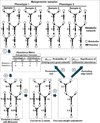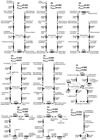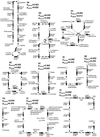MetaPath: identifying differentially abundant metabolic pathways in metagenomic datasets
- PMID: 21554767
- PMCID: PMC3090767
- DOI: 10.1186/1753-6561-5-S2-S9
MetaPath: identifying differentially abundant metabolic pathways in metagenomic datasets
Abstract
Background: Enabled by rapid advances in sequencing technology, metagenomic studies aim to characterize entire communities of microbes bypassing the need for culturing individual bacterial members. One major goal of metagenomic studies is to identify specific functional adaptations of microbial communities to their habitats. The functional profile and the abundances for a sample can be estimated by mapping metagenomic sequences to the global metabolic network consisting of thousands of molecular reactions. Here we describe a powerful analytical method (MetaPath) that can identify differentially abundant pathways in metagenomic datasets, relying on a combination of metagenomic sequence data and prior metabolic pathway knowledge.
Methods: First, we introduce a scoring function for an arbitrary subnetwork and find the max-weight subnetwork in the global network by a greedy search algorithm. Then we compute two p values (pabund and pstruct) using nonparametric approaches to answer two different statistical questions: (1) is this subnetwork differentically abundant? (2) What is the probability of finding such good subnetworks by chance given the data and network structure? Finally, significant metabolic subnetworks are discovered based on these two p values.
Results: In order to validate our methods, we have designed a simulated metabolic pathways dataset and show that MetaPath outperforms other commonly used approaches. We also demonstrate the power of our methods in analyzing two publicly available metagenomic datasets, and show that the subnetworks identified by MetaPath provide valuable insights into the biological activities of the microbiome.
Conclusions: We have introduced a statistical method for finding significant metabolic subnetworks from metagenomic datasets. Compared with previous methods, results from MetaPath are more robust against noise in the data, and have significantly higher sensitivity and specificity (when tested on simulated datasets). When applied to two publicly available metagenomic datasets, the output of MetaPath is consistent with previous observations and also provides several new insights into the metabolic activity of the gut microbiome. The software is freely available at http://metapath.cbcb.umd.edu.
Figures






Similar articles
-
Statistical methods for detecting differentially abundant features in clinical metagenomic samples.PLoS Comput Biol. 2009 Apr;5(4):e1000352. doi: 10.1371/journal.pcbi.1000352. Epub 2009 Apr 10. PLoS Comput Biol. 2009. PMID: 19360128 Free PMC article.
-
GSNFS: Gene subnetwork biomarker identification of lung cancer expression data.BMC Med Genomics. 2016 Dec 5;9(Suppl 3):70. doi: 10.1186/s12920-016-0231-4. BMC Med Genomics. 2016. PMID: 28117655 Free PMC article.
-
Accurate and fast estimation of taxonomic profiles from metagenomic shotgun sequences.BMC Genomics. 2011;12 Suppl 2(Suppl 2):S4. doi: 10.1186/1471-2164-12-S2-S4. Epub 2011 Jul 27. BMC Genomics. 2011. PMID: 21989143 Free PMC article.
-
COGNIZER: A Framework for Functional Annotation of Metagenomic Datasets.PLoS One. 2015 Nov 11;10(11):e0142102. doi: 10.1371/journal.pone.0142102. eCollection 2015. PLoS One. 2015. PMID: 26561344 Free PMC article.
-
Application of computational approaches to analyze metagenomic data.J Microbiol. 2021 Mar;59(3):233-241. doi: 10.1007/s12275-021-0632-8. Epub 2021 Feb 10. J Microbiol. 2021. PMID: 33565054 Review.
Cited by
-
The gutSMASH web server: automated identification of primary metabolic gene clusters from the gut microbiota.Nucleic Acids Res. 2021 Jul 2;49(W1):W263-W270. doi: 10.1093/nar/gkab353. Nucleic Acids Res. 2021. PMID: 34019648 Free PMC article.
-
Exploring the Human Microbiome: The Potential Future Role of Next-Generation Sequencing in Disease Diagnosis and Treatment.Front Immunol. 2019 Jan 7;9:2868. doi: 10.3389/fimmu.2018.02868. eCollection 2018. Front Immunol. 2019. PMID: 30666248 Free PMC article. Review.
-
Analytical tools and databases for metagenomics in the next-generation sequencing era.Genomics Inform. 2013 Sep;11(3):102-13. doi: 10.5808/GI.2013.11.3.102. Epub 2013 Sep 30. Genomics Inform. 2013. PMID: 24124405 Free PMC article. Review.
-
BiG-MAP: an Automated Pipeline To Profile Metabolic Gene Cluster Abundance and Expression in Microbiomes.mSystems. 2021 Oct 26;6(5):e0093721. doi: 10.1128/mSystems.00937-21. Epub 2021 Sep 28. mSystems. 2021. PMID: 34581602 Free PMC article.
-
Cytometric fingerprinting for analyzing microbial intracommunity structure variation and identifying subcommunity function.Nat Protoc. 2013 Jan;8(1):190-202. doi: 10.1038/nprot.2012.149. Epub 2013 Jan 3. Nat Protoc. 2013. PMID: 23288319
References
-
- Meyer F, Paarmann D, D'Souza M, Olson R, Glass EM, Kubal M, Paczian T, Rodriguez A, Stevens R, Wilke A. et al.The metagenomics RAST server - a public resource for the automatic phylogenetic and functional analysis of metagenomes. BMC Bioinformatics. 2008;9:386. doi: 10.1186/1471-2105-9-386. - DOI - PMC - PubMed
LinkOut - more resources
Full Text Sources

